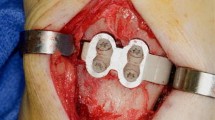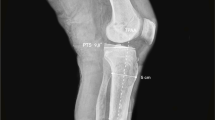Abstract
Purpose
To document the effectiveness of a novel technique to decrease tibial slope in patients who underwent a proximal opening-wedge osteotomy with an anteriorly sloped plate placed in a posteromedial position. The hypothesis was that posteromedial placement of an anteriorly sloped osteotomy plate with an adjunctive anterior bone staple on the tibia would decrease, and maintain, the tibial slope correction at a minimum of 6 months following the osteotomy.
Methods
All patients who underwent biplanar medial opening-wedge proximal tibial osteotomy with anterior staple augmentation to decrease sagittal plane tibial slope were included, and data were collected prospectively and reviewed retrospectively. Indications for decreasing tibial slope included medial compartment osteoarthritis with at least one of the following: ACL deficiency, posterior meniscus deficiency, or flexion contracture. Preoperative, immediate postoperative, and 6-month postoperative radiographs were reviewed.
Results
Twenty-one patients (14 males and 7 females) were included in the study with a mean age of 36.5 years. Intrarater and interrater reliability of slope measurements were excellent at all time points (ICC ≥ 0.94, ICC ≥ 0.85). The osteotomy resulted in an average tibial slope decrease of 0.8 from preoperative (n.s.). At 6-month postoperative, average slope was not significantly different from time-zero postoperative slope (mean = +0.2°).
Conclusions
The most important finding of this study was that posteromedial placement of an anteriorly angled osteotomy plate augmented with an anterior staple during a biplanar medial opening-wedge proximal tibial osteotomy did not decrease sagittal plane tibial slope. Whether a staple was effective in maintaining tibial slope from time zero to 6 months postoperatively was unable to be assessed due to no significant change in tibial slope from the preoperative postoperative states. The results of this study note that current osteotomy plate designs and surgical techniques are not effective in decreasing sagittal plane tibial slope.
Level of evidence
IV.




Similar content being viewed by others
References
Agneskirchner JD, Hurschler C, Stukenborg-Colsman C, Imhoff AB, Lobenhoffer P (2004) Effect of high tibial flexion osteotomy on cartilage pressure and joint kinematics: a biomechanical study in human cadaveric knees. Winner of the AGA-DonJoy Award 2004. Arch Orthop Trauma Surg 124:575–584
Arthur A, LaPrade RF, Agel J (2007) Proximal tibial opening wedge osteotomy as the initial treatment for chronic posterolateral corner deficiency in the varus knee: a prospective clinical study. Am J Sports Med 35:1844–1850
Arun GR, Kumaraswamy V, Rajan D et al (2015) Long-term follow up of single-stage anterior cruciate ligament reconstruction and high tibial osteotomy and its relation with posterior tibial slope. Arch Orthop Trauma Surg 136(4):505–511
Blackman AJ, Krych AJ, Engasser WM et al (2015) Does proximal tibial osteotomy with a novel osteotomy system obtain coronal plane correction without affecting tibial slope and patellar height? Knee Surg Sports Traumatol Arthrosc 23:3487–3493
Birmingham TB, Giffin JR, Chesworth BM et al (2009) Medial opening wedge high tibial osteotomy: a prospective cohort study of gait, radiographic, and patient-reported outcomes. Arthritis Rheum 61:648–657
Canty A, Ripley B (2015). boot: Bootstrap R (S-Plus) Functions. R package version 1.3–16
Cerciello S, Vasso M, Maffulli N, Neyret P, Corona K, Panni AS (2014) Total knee arthroplasty after high tibial osteotomy. Orthopedics 37:191–198
Christensen JJ, Krych AJ, Engasser WM, Vanhees MK, Collins MS, Dahm DL (2015) Lateral tibial posterior slope is increased in patients with early graft failure after anterior cruciate ligament reconstruction. Am J Sports Med 43:2510–2514
Cotic M, Vogt S, Feucht MJ et al (2015) Prospective evaluation of a new plate fixator for valgus producing medial open-wedge high tibial osteotomy. Knee Surg Sports Traumatol Arthrosc 23:3707–3716
Cotic M, Vogt S, Hinterwimmer S et al (2015) A matched-pair comparison of two different locking plates for valgus-producing medial open-wedge high tibial osteotomy: peek-carbon composite plate versus titanium plate. Knee Surg Sports Traumatol Arthrosc 23:2032–2040
Giffin JR, Vogrin TM, Zantop T, Woo SL, Harner CD (2004) Effects of increasing tibial slope on the biomechanics of the knee. Am J Sports Med 32:376–382
Hernigou P, Medevielle D, Debeyre J, Goutallier D (1987) Proximal tibial osteotomy for osteoarthritis with varus deformity. A ten to thirteen-year follow-up study. J Bone Joint Surg Am 69:332–354
Huizinga MR, Brouwer RW, van Raaij TM (2014) High tibial osteotomy: closed wedge versus combined wedge osteotomy. BMC Musculoskelet Disord 11:124
Jackman T, LaPrade RF, Pontinen T, Lender PA (2008) Intraobserver and interobserver reliability of the kneeling technique of stress radiography for the evaluation of posterior knee laxity. Am J Sports Med 36:1571–1576
Jacobi M, Villa V, Reischl N et al (2015) Factors influencing posterior tibial slope and tibial rotation in opening wedge high tibial osteotomy. Knee Surg Sports Traumatol Arthrosc 23:2762–2768
LaPrade RF, Bernhardson AS, Griffith CJ, Macalena JA, Wijdicks CA (2010) Correlation of valgus stress radiographs with medial knee ligament injuries: an in vitro biomechanical study. Am J Sports Med 38:330–338
LaPrade RF, Heikes C, Bakker AJ, Jakobsen RB (2008) The reproducibility and repeatability of varus stress radiographs in the assessment of isolated fibular collateral ligament and grade-III posterolateral knee injuries. An in vitro biomechanical study. J Bone Joint Surg Am 90:2069–2076
LaPrade RF, Oro FB, Ziegler CG, Wijdicks CA, Walsh MP (2010) Patellar height and tibial slope after opening-wedge proximal tibial osteotomy: a prospective study. Am J Sports Med 38:160–170
LaPrade RF, Spiridonov SI, Nystrom LM, Jansson KS (2012) Prospective outcomes of young and middle-aged adults with medial compartment osteoarthritis treated with a proximal tibial opening wedge osteotomy. Arthroscopy 28:354–364
Lee YS, Kang JY, Lee MC, Elazab A, Choi UH, Kang SG, Lee KJ, Lee S (2015) Osteotomy configuration of the proximal wedge and analysis of the affecting factors in the medial open-wedge high tibial osteotomy. Knee Surg Sports Traumatol Arthrosc. doi:10.1007/s00167-015-3819-x
Lustig S, Scholes CJ, Costa AJ, Coolican MJ, Parker DA (2013) Different changes in slope between the medial and lateral tibial plateau after open-wedge high tibial osteotomy. Knee Surg Sports Traumatol Arthrosc 21:32–38
Madry H, Goebel L, Hoffmann A, Dück K, Gerich T, Seil R, Tschernig T, Pape D (2016) Surgical anatomy of medial open-wedge high tibial osteotomy: crucial steps and pitfalls. Knee Surg Sports Traumatol Arthrosc. doi:10.1007/s00167-016-4181-3
Moon SW, Park SH, Lee BH, Oh M, Chang M, Ahn JH, Wang JH (2015) The Effect of hinge position on posterior tibial slope in medial open-wedge high tibial osteotomy. Arthroscopy 31:1128
Okamoto R, Koshino T, Morii T (1993) Shortening of patellar ligament and patella baja with improvement of quadriceps muscle strength after high tibial osteotomy. Bull Hosp Jt Dis 53:21–24
Ozel O, Yucel B, Mutlu S, Orman O, Mutlu H (2015) Changes in posterior tibial slope angle in patients undergoing open-wedge high tibial osteotomy for varus gonarthrosis. Knee Surg Sports Traumatol Arthrosc. doi:10.1007/s00167-015-3571-2
Paley D, Pfeil J (2000) Principles of deformity correction around the knee. Orthopade 29:18–38
Rodner CM, Adams DJ, Diaz-Doran V et al (2006) Medial opening wedge tibial osteotomy and the sagittal plane. Am J Sports Med 34:1431–1441
Wang JH, Bae JH, Lim HC, Shon WY, Kim CW, Cho JW (2009) Medial open wedge high tibial osteotomy: the effect of the cortical hinge on posterior tibial slope. Am J Sports Med 37:2411–2418
Acknowledgments
The author, Robert F. LaPrade is on the editorial/governing board for AJSM and KSSTA and has member/committee appointments for AOSSM, ISAKOS, AANA, and ESSKA. Dr. LaPrade is a consultant and receives royalties from Arthrex, Ossur, Smith & Nephew. The Steadman Philippon Research Institute has received financial support not related to this reaerch from the following: Arthrex Inc, Ossur Americas, Smith & Nephew Endoscopy.
Author information
Authors and Affiliations
Corresponding author
Ethics declarations
Conflict of interest
The authors declare that they have no conflict of interest.
Funding
No funds were received to do this research.
Ethical approval
This study was approved and performed in accordance with the standards set forth by our institutional review board.
Informed consent
Informed consent was obtained for each patient in the study prior to the surgical procedure.
Rights and permissions
About this article
Cite this article
Dean, C.S., Chahla, J., Matheny, L.M. et al. Posteromedially placed plates with anterior staple reinforcement are not successful in decreasing tibial slope in opening-wedge proximal tibial osteotomy. Knee Surg Sports Traumatol Arthrosc 25, 3687–3694 (2017). https://doi.org/10.1007/s00167-016-4311-y
Received:
Accepted:
Published:
Issue Date:
DOI: https://doi.org/10.1007/s00167-016-4311-y




